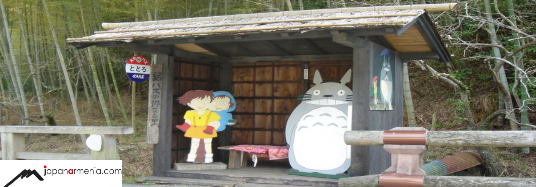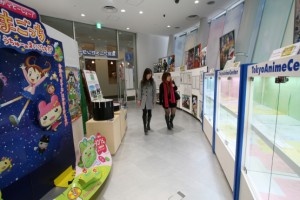
Anime
«Romance in pictures»-maybe this is the most typical translation of Japanese word «manga». This is form of descriptive art and literature. Manga readers are of different agd having different interests.
Manga is a creation of the most different genres. Manga can be adventurous, romantic, sport, historical, humorous, scientific-fantastic, horror, erotic or so on. The word «manga» was used by famous Japanese painter Katsusiki Khakusaem in 1814. At that time his created book was description of white and black eskizes. He titled the book «Manga» (automatic eskizes). Beginning from that time, manga was named those books which were depicted with white and black ink illustrations. Almost all manga was depicted and published with white and black colors. However, there is also colorful manga, too. As a rule, the famous manga leads to the shot of anime. Nevertheless, there are cases when manga is created from already existed anime or film, for instance, «Star Wars».
History
In Japan first evidences of history description with illustrations were in the 12th century. At that time, the Buddhist monarch Toba described 4 humorous histories. The monarch creations told about animals, illustrated people and about Buddhist monarchs. The creations consisted of 4 papers depicted with ink illustrations. Currently, those creations are kept in monasteries where Toba lived. The lines used in his creations are now the elements of contemporary manga, for example, the men feet illustration in a running position.
Being enlarged, manga included in itself the ukiyo traditions. Ukiyo is translated as «Swimming world illustrations». Ukiyo describes the instant, transitory life and nature. In Japan this branch of art was enlarged at the end of the 17th century. It continued to be one of the most famous artistic styles in Japan. This style describes aesthetics and can be seen in contemporary manga and anime. After the restoration of Meidvi when Japanese isolation period was terminated from inner world, the painters began to study from their foreign colleagues. They mainly studied the characteristics of compositions, elements and colors. Little attention was paid to those characteristics in ukiyo-e. For example, the meaning and the idea of picture were more important than the form of it. The contemporary form of manga appeared during World War ΙΙ and especially after war.
During the war manga considered to be the means of propaganda. It was colorfully published on a good quality paper. Manga publication was funded by the government (it was called «Tokyo manga» in an informal way). After the end of the war when the country was on the ruins, «osa manga» appeared instead of manga. The «osa manga» was published on the cheapest paper. In 1947 Osamu Tedzuka published his manga «Shin Takarajima» (new island of treasures). The number of publication reached to 400. 000. This creation of Tedzuka differentiated many elements of manga with its contemporary form. During his lifetime Tedzuka left a number of creations. He had pupils and posterities who worked out his ideas. They made manga a complete form of a huge culture (moreover, not complete form but fundamental one).
General information
In Japan manga readers are of different age. It is accepted both art illustrations form and literature phenomenon. Accordingly, there are a number of mangas of different genres and different topics. Almost all manga is published and illustrated with white and black colors. Famous manga leads to the shot of anime. Manga illustrating painter is called «mangaka». Frequently, this person is considered to be the screen writer. If screen writer is another person so he/she is called «gensakusia». Manga reading is widespread. The reason is Japanese writing. Moreover, hieroglyph columns are written in this way.
Manga publication is the quarter part of the whole Japan publication. At the beginning, the vast majority was published mainly in thick journals (from 200 up to 1000 pages) which were more than 100. However, there are manga series that republished in different quantities, so called «tankobons».
Manga is usually classified according to the readers’ sex or age. For instance,
•Jozei-it is for women more than 20 years-old. It mainly includes housewives and secretaries. This type of manga reaches nearly to those quantities as the romances in the west.
•Soujo-it is for girls from 6 up to 18 years-old. Here great attention is paid to the hair styles, fashion, romantic images, feelings and mood.
•Shounen-it is for boys. It is famous manga form for teenagers. Here the activities are carried out in schools and in sport.
•Sheinen-it is for men from 18 up to 25 years-old. It includes a lot of violence and sexual scenes. Here the activities are carried out among students, employees and unemployed people.
There are different genres and topics of manga. Manga relation with this or that genre is usually noted with a special logo. Accordingly, in choosing manga publication it needs to pay attention to the logo. For example, (yoy) genre has homosexual meaning and (yuri) genre lesbian one.
Manga fans
Manga influence on international market was essentially enlarged during the last several decades. Besides, Japan manga has great recognition in the USA, Canada, Germany, France and Poland. All over the world the fans of anime and manga are usually called «o-taku». However, this word hasn’t usage in Japan. Moreover, this word has negative meaning there (the translation is near to follower than fan).
•Fan-fic-(Fan fiction)-it is a romantic serial or film. Fan fiction (fanfic) can be continuation, background, parody, alternative universe, over cross (a «mix» of several creations).
•Fine-art-it is fine art creation of manga fans. It includes computer collages, original pictures, dodzinsi (the approximate translation will be any self-creation manga which is made with the motives of already existed manga, anime and plays).
Unlike fine art literature, fine art doesn’t provide compulsory illustration of already existed scenes or characters. It is enough to have «feeling of similarity».
These styles were enlarged not only in Japan but also out of the country’s borders. It became Cosplay which includes the uniform specifications of manga and anime characters as well as the participation to different parades and contests.
Different types of graphic illustrations…
•Renga-«sequential illustrations». Unlike manga graphic illustrartion, this types is briefly used the square of the page (usually there is only one illustration on the page). It hasn’t many dialogues. The exchanged illustrations are also called sequential illustrations.
•Gekiga-«dramatic illustration». This is an important creation in classic theater and cinema traditions. The serious, real illustrations of characters as well as the literary logical plot are considered to be the elements of gekiga. This type became famous in the 60th-s of the 20thcentury, mainly due to the films of Akiro Kurasavi. Nowadays, gekiga is considered to be a type of manga. Sometimes it is illustrated in teenager (shounen) journals. Although, this type is for the readers under forty.
•Jon-koma-«brief manga». As a rule, it consists of 4 parts. Jon-koma is mainly published in newspapers and journals. The plot is usually humorous, sometimes even comedy in nature.

the material is taken from http://visitjapan.ru/japan/anime/
translated from Armenian into English by Tatev Harutyunyan










